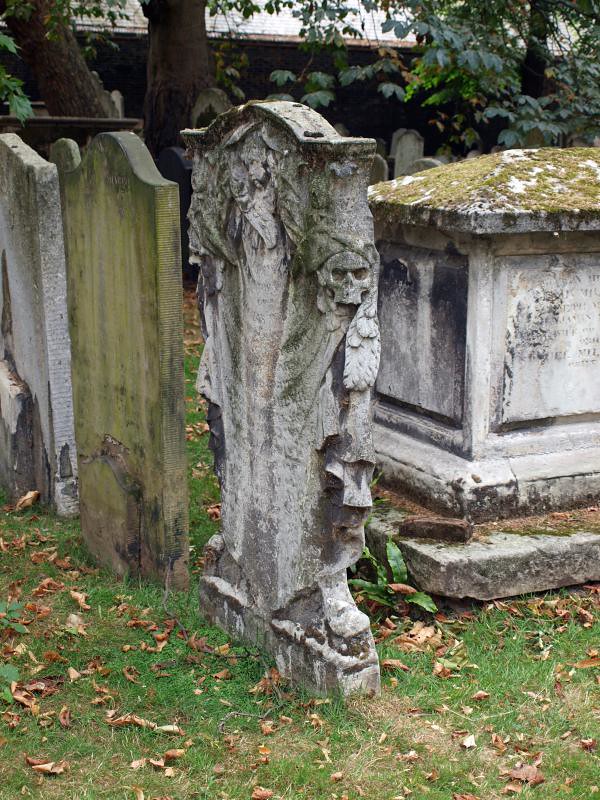Having said that it's very atmospheric and I did get to see Daniel Defoe, John Bunyan and William Blake's memorials.
HERE men were living in pile dwellings when Christ was born in Bethlehem, and stone tools have been picked up that were dropped long before then in what is now Clerkenwell Road. Here in the Middle Ages the youth of London came to skate and slide, and the wildfowler to shoot. It was not till the days of Plague and Fire that refugees from those twin calamities set up the first regular buildings in the marshes here. It became the home of the doctors long before Harley Street, and centuries have passed since watchmakers and jewellers and opticians made Clerkenwell their home. It has been the home of ancient and modern Crusaders, the Knights of St John of Jerusalem, and the Evangelists inspired by John Wesley. Today in working hours there are in Finsbury an average of 450 busy people for every one of its acres, though it is the smallest but one of all London boroughs, with only 587 acres.
It has within its borders a spot for ever sacred in the history of our race, a shabby place that should be made more beautiful. It is the little graveyard of Bunhill Fields. There is not an acre of English earth more precious than this, where we may look across the graves of four of England’s matchless men, John Bunyan, Isaac Watts, Daniel Defoe, and William Blake. One gave us the first great English story that will never die. One gave us the hymn sung by our race in all its triumphs and tribulations. One gave us a book beloved by every English speaking boy. One gave us our national anthem Jerusalem. In Bunhill Fields they lie almost together.
Blake’s grave is unmarked, but Bunyan’s has a sleeping stone figure of the immortal tinker and reliefs showing Christian with his burden and carrying the cross. The granite obelisk over Defoe’s grave was set up last century by 1700 youthful admirers of Robinson Crusoe, and near it is an obelisk to Isaac Watts, who was carried here from Lady Abney’s house at Stoke Newington, where he lived for 36 years. In a green space close by in Roseve Street lies George Fox, the heroic founder of the Quakers, and across the street lies John Wesley. Bunyan and Blake, Watts and Defoe, Wesley and Fox - we may wonder if anywhere else lie six such men in such a little space.
It is said that over a hundred thousand Nonconformists lie here, mingled with thousands of bones moved in Elizabethan days from Old St Paul’s. Here they brought criminals and victims of the Plague, mingling good and evil, proud and lowly. John Wesley laid his mother here, and here they laid General Fleetwood, who fought with Cromwell at Dunbar and married the Protector’s daughter. Near him lies the favourite minister of Cromwell, Thomas Goodwin, whose services the king refused with thanks before going to the scaffold, and who in a few years more stood by a bed in that same place while Cromwell passed away.
John Wesley lies across the City Road in the little graveyard behind his chapel, the mother of 108,000 churches. His bronze statue is under the trees, and shows him as a kindly-looking man in flowing robes, one hand raised in exhortation and in the other his little field Bible. On the pedestal are his famous words, The world is my parish. It was Wesley himself who laid the foundation stone of the chapel he made so famous. Here his body lay in state while thousands thronged past the coffin, looking on his face. Much of the building is as he knew it, though by the gabled front is a porch set on its columns about the time of Waterloo. In the lobby is a bronze relief of an angel mourning for 26,000 Wesleyans who fell in the war. Along the front wall stand six pine masts from English battleships, presented to Wesley by George the Third for supporting the gallery. Between them is a fine window by Frank Salisbury, a glow of inspiring colour, with a fiery figure of Sir Galahad brandishing a sword over the shadowy forms of Envy, Jealousy, and Greed, while below are the thrilling words of Blake’s Jerusalem.

No comments:
Post a Comment